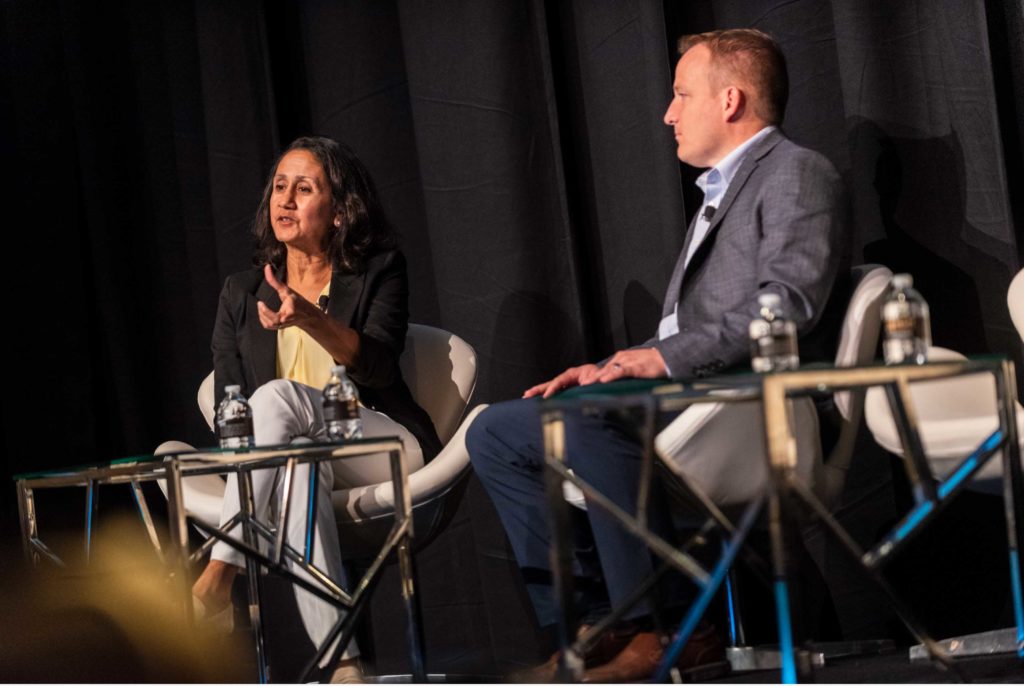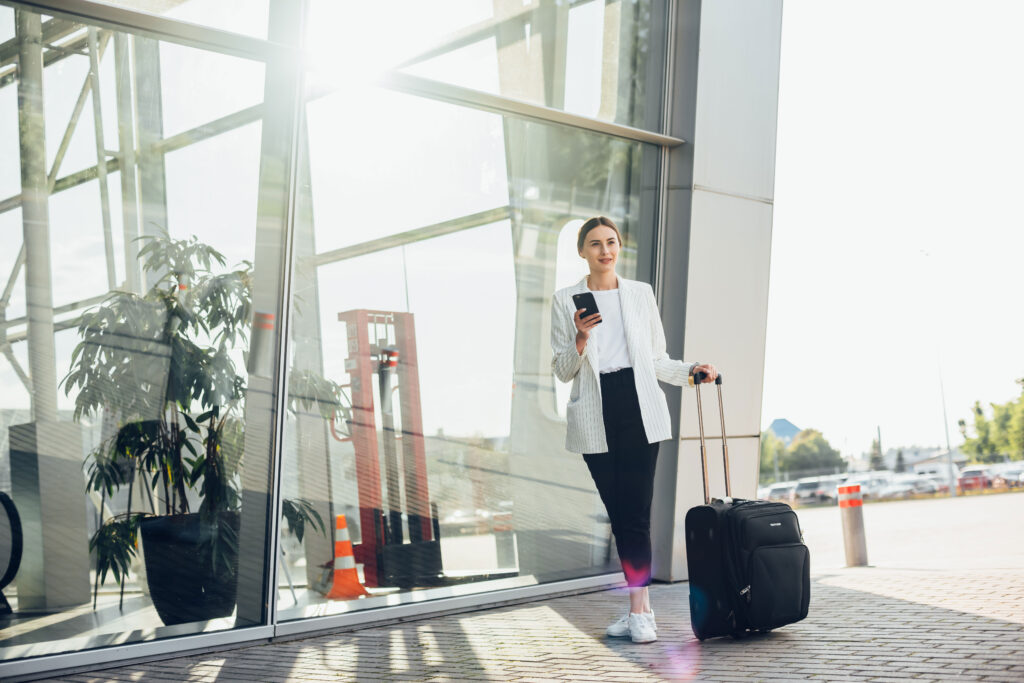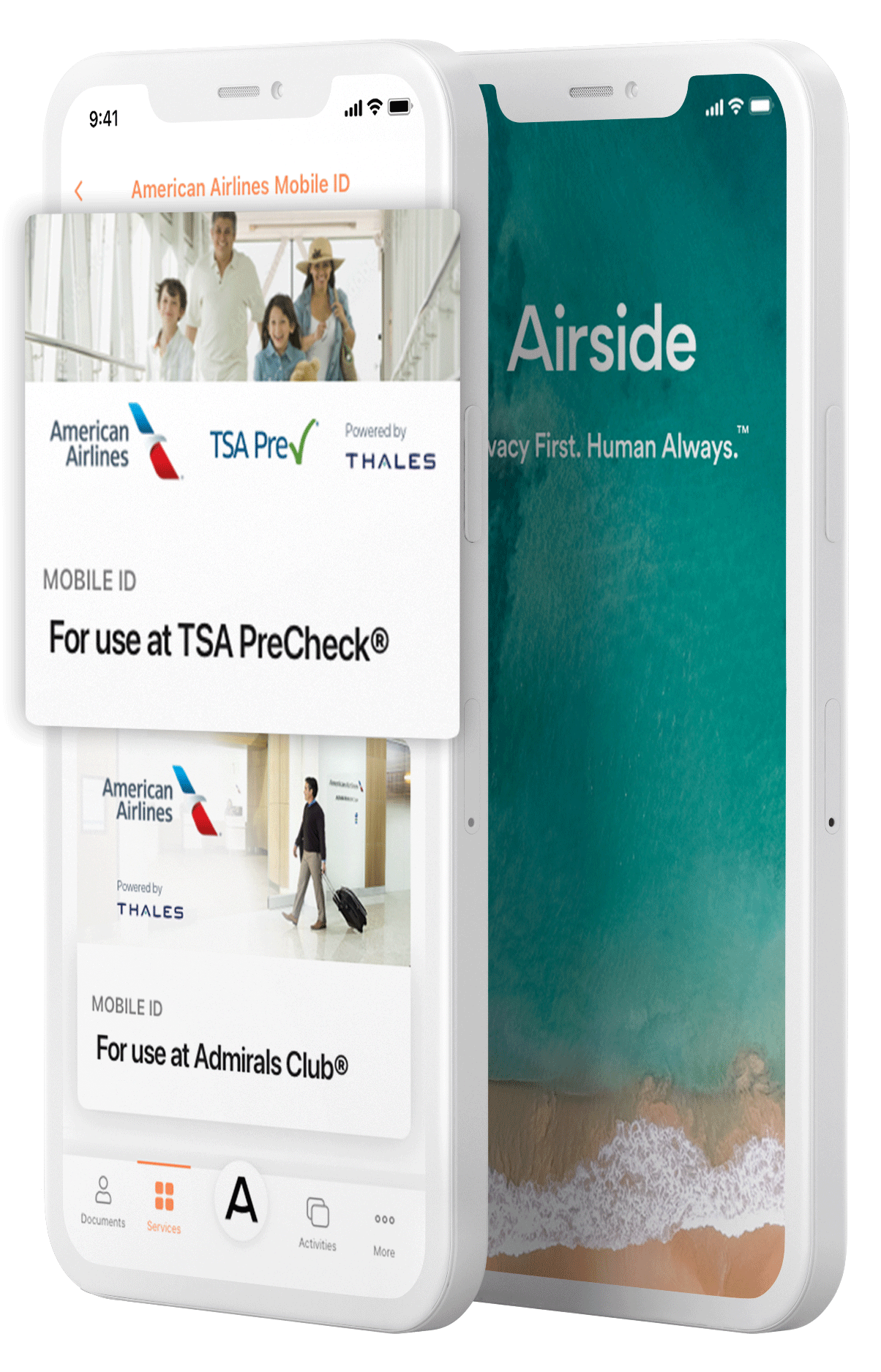Copyright Airside Mobile, Inc. an Entrust Company, 2025. All rights reserved.
The future is now! American Airlines and Airside discuss mobile ID at FTE Global 2022

Amena Ali, CEO Airside and Preston Peterson, Director of Customer Experience Innovation, American Airlines
Amena Ali: I’m delighted to have Preston join me on stage here. We’re here this morning to talk about what we’ve done together and where we’re headed. A little bit of background on us: you and I have had an ongoing conversation for about two years now as we’ve been working to bring biometrics to bag drop and lounge and, most recently in June of this year, with the launch of the American Airlines mobile ID program together at the checkpoint with TSA PreCheck. We’ll chat with you a little bit about that and about where we’re going next. For those of you who are not familiar with the launch we did, we’re delighted to work with Preston and his whole team, a number of whom are here, to enable people to get through the checkpoint a bit faster. Before we go on, give us some context about how you think about the journey overall and where the checkpoint fits into that as we think about the customer experience.
Preston Peterson: Yes. When I started on this team in early 2019 security was that one complement of the journey that was missing from what we look at from an airline. It was check-in and lounge and boarding a flight. But, if you look at customer satisfaction, security is an absolute piece of that journey. Customers don’t like standing in line and they don’t like missing their flight because they couldn’t get through security. They go back to the airline and say, “What are you going to do to get me to my destination?” So, we incorporated that as part of our overall journey. The challenge here with the airport experience is that for all airlines, today, it’s a different experience, depending on the touchpoint. You may need a boarding pass or an ID. Or, to get into the lounge you might need a credit card. If you’re going on an international flight, depending on which airport you’re at, you might be able to use your face, but you still might need a boarding pass. Then, we also have these confusing terms like record locators and confirmation numbers and things like that. Our goal with using biometrics in the airport is to create a consistent experience at each touchpoint where you can use your digital ID and your face to get through those touchpoints in a consistent way. A really quick example of that is with the mobile ID program we have at DFW plus in our Admirals Club. Today, I can put my phone away once I go through the TSA checkpoint and I can walk straight into an Admirals Club using my face. My phone stays in my bag, so I’m not fumbling around with it or my documents.
Amena Ali: Absolutely. We’re showing some video here. Our focus is on ubiquity and bringing this to all passengers, starting with PreCheck passengers. [The mobile ID program applies] to all phones: your Android phone, your iPhone. Also, [there’s] really broad coverage in terms of all the AAMVA states for driver’s licenses, plus passports to cover other key states as well. And, [we started] getting that going with DFW. It’s been a great experience. Let’s pause and think about where this journey is going. Of course, people don’t want to stand in line. I think it’d be helpful to think about where biometrics fit into the context of what people expect. The last panel was all about human technology interaction and what people want. Let’s talk about it. You’ve got kids. How do they interact with technology and what can we learn from that to make travel better?
Preston Peterson: Sure. To your first point there, there’s a perception by many that biometrics are scary and your data isn’t secure, it’s not safe. There’s nothing farther from the truth. Just by a show of hands, how many of you like to hand your driver’s license over and share your eye color, hair color, and weight with a random person you don’t know? No hands. And, that’s what we do today when we go through a security checkpoint or we drop a bag. You give your information to somebody you don’t know. The beauty of biometrics and multiple IDs is that all that person on the other end sees is a “yes” or “no.” It’s pretty simple. More than 70% of consumers today are open to the idea of using a biometric to interact with an airline or different touchpoints. Speaking of my kids, a funny thing happened recently when we were walking out of this building, and one of my children saw this device that was hung on a wall that had a cord on it. It was a telephone, but my children are young enough so they don’t know that. She’s used to mobile phones, right? Kids and the younger generation expect speed and convenience. Why would you possibly need to walk over to your phone on a wall when you have one in your pocket? The same idea applies with biometrics and mobile IDs. Why do I have to pull out a separate document for each touchpoint when I could use one document and my face to transact and transit through different customers?
Amena Ali: I couldn’t agree with you more. The way we think about it, it’s really that analog to digital movement. The rotary phone went the way of the push button phone, went the way of landlines to cell phones. What’s the next step beyond that? Where’s mobile technology taking you? In today’s day and age, people are legitimately focused on privacy and their PII and [asking], “Who’s getting what information?” You’re absolutely right. I don’t want to be showing all my information at every step along the way. I want convenience and control. To us, privacy-by-design is critical. Consumer consent is critical. And, making sure we’re respecting that. The other anecdote that I will share [is about my] kids in their 20s. Their interaction with money is very different from, say, my parents’ generation. They don’t regularly go to the ATM to take out cash, to settle bills at a restaurant, right? It’s all digital. I think once people get used to [digitization], it’s kind of like breathing, right? It’s just what you do. You show up and it happens. And, it’s what you expect. Let’s come back to what we started with mobile ID. Here’s the irony: the simpler something is, the [bigger and more complicated] the amount of work and all the years needed to [make it] come together. I want to acknowledge all of our partners that made this possible. Obviously, American Airlines, Thales, DFW and, of course, TSA. Let’s talk about what sort of partnerships are required to create these beautiful, seamless, delightful experiences.
Preston Peterson: You know, one of the things that I referenced on the panel yesterday that we had with DFW, TSA, and Pangiam was the fact that [in the not-too-distant past] we all worked in silos and we did our own things. Maybe toward the end of a project, we would talk and say, “By the way, here’s what we’re doing. Would you like to participate?” At that point, it’s too late. What’s been different about this is we all started together from the beginning. What we did at American is we sat down and laid out the vision and shared that vision across the stakeholders and said, “Here’s what we want to do.” We piggybacked off of the biometric exit mandate and said, “How can we further develop this in the airport space to use that biometric across multiple touchpoints?” It’s key to share that vision and get everybody aligned with it, to be working together from that initial stage versus trying to figure out how you fit it all together toward the end. That’s been the biggest piece about this. It’s working together, sharing that vision, and ultimately, we’re still in it together. Now, we’re deploying something. There has to be skin in the game for everybody. Everybody wants to see it be successful.
Amena Ali: The other thing is that openness and interoperability is really key to making something like this work. Openness from the perspective of the technology. It needs to be open from the beginning to be able to use it. For example, in this case, the ISO 18013-5 standard. Now, everyone’s playing by the same book in terms of what’s the standard we’re using. As in, “How are you working together for us?” Our interoperability is key so our customers and relying parties have a choice of solutions they’re going to use and our product works with all of them. Then, I would say that communication is absolutely key, right? When you’re going where no one has gone before you’re going to say, “I’ve been learning a lot of things along the way.” To the chart that Doug [O’Gordon] showed in terms of the book Crossing the Chasm, what happens in that early adoption? There’s a lot of learning going on and [it’s vital that you’re] able to iterate and learn and share information and build trust. That’s really how our teams have worked.
Preston Peterson: She has ISO standards memorized like that. That’s super.
Amena Ali: Here’s a photo, speaking of teamwork, from our launch day at DFW, which was great. Let’s talk about where we’re going from here. In today’s day and age, every experience I have for every point in the journey I need to attest to who I am and disclose to you that I am who I am over and over again. There’s very little reusability and connection between my identity in each step of the way. Let’s touch on that briefly, in terms of what is the journey that you will want your kids to go on when they fly American in, say, two years from now, tomorrow, five years from now.
Preston Peterson: The ideal is: let’s get going. Let’s get this out there. My kids might use this at every touchpoint: a kiosk, a bag drop, security, getting into the lounge, not only boarding international flights, but domestic flights as well. And, then beyond that. The near term focus is certainly on the airport and airline environment. I will say this is not something that we, at American, view as a medium or long term competitive advantage. This is where the industry is going. This is a standard. This will be foundational. Customers will expect it because they’ll see the value. [Here’s an] analogy: by show of hands, how many of you in the past week have used a digital wallet? That’s a lot of people. By the same hands, 10 years ago, how many of you were doing the same? Zero, right? It’s probably been five years ago if we’re being honest for most people. It just accelerated. We view the same thing with mobile IDs. Ten years from now, the same number of hands will be raised saying, “That’s how I boarded my flight. That’s how I pulled up my reservation. That’s how I rented a car, got into a hotel, and bought a beer at the sports stadium.” We view this as a near term focus, getting through the airport environment, but, for this to really stick, it has to go beyond that. We need more partners in this space to be able to use that digital identity and use facial recognition so that it becomes sticky every day for customers to use this across multiple touchpoints.
Amena Ali: I couldn’t agree with you more. I’ll say two things. One is that, today, you need to take out your phone and engage in some way. The other is that it offers auto-magical experiences to just show up and look at the camera, right? That’s really where we want the next step to be, right?
Preston Peterson: Auto-magical? That’s fantastic. I’m stealing that.
Amena Ali: If you use technology to do the heavy lifting ahead of time and use consent to share that information rather than worrying, “Oh no, is my phone timing out? Am I going into my wallet? What app am I pulling up?” This actually happened to me coming here. I wanted to go up and ask, “Is there an e-gate? Is there something [where] I just show my face and go?” That technology is here. It’s happening. You’ve got lots of vendors who are doing that. I think we dream of a world where it’s that simple. With control and consent you’re providing these delightful experiences when you’re boarding a flight, checking into a hotel and whatnot. Then, think about all the other places where identity is a challenge right now. Let’s say you want to get a phone, right? What is that process for you to attest your identity in getting a new phone, or opening a bank account or transacting with money in some way? The average number of clicks required to open a new bank account, even digitally, is 120. That is a lot of clicks. When you go to the doctor, [think about] how many times you’ve shared your medical history and filled out the same form over and over. We see this as a beautiful opportunity to use digital identity and how you share that in a decentralized way and with consent. This makes experiences much more delightful. We’re happy to be here with you and our partners and we’re happy to demo our solution for you. You don’t just have to take our word for it. Come on by our booth and we can show you how it works with our various partners, for example, Vision Box and IDEMIA.










